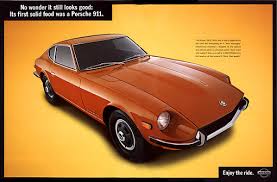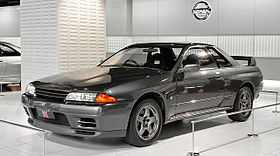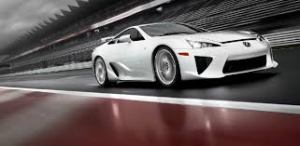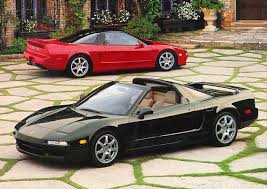Regular readers might be surprised at my topic of choice for this post but bear with me as I think there are more than a few interesting things that have emanated from the land of the rising sun. It is true that more bland, insipid and downright boring cars have been produced per head of population in Japan (or of Japanese origin) than anywhere else on earth. This however is only part of the picture. In an incredibly short space of time they have completely changed how cars are manufactured, perceived and what we as consumers expect of them. Through some small cracks of their (mostly justified) renowned reliability and almost unremitting drabness have seeped some absolute gems not to mention some bonkers left of field creations.

I have to confess to a slightly bemused smile every time I see one of their off the wall creations (Nissan’s Cube or horrible Figaro, any of Toyota’s weird WiLLs and Daihatsu’s Copen all fit this category) but they don’t really keep my attention and certainly won’t be the focus of this essay. Before we get to the really good stuff though it’s worth looking at how far Japanese manufacturers have come in such a short time and how surprising it is that they have produced anything worthy of inclusion on these pages.
We’ve all heard the stories about how the Japanese actually made cars reliable. My favourite anecdote is the one where they looked to U.S. production lines in the sixties (which with one or two notable exceptions produced big, fat, ugly and unreliable cars – ‘Vettes and Mustangs weren’t ugly or fat) and saw that there were loads of spare parts easily to hand for when things (as they often did) went wrong. The thinking behind this was that the production line should never slow down so running repairs would be carried out when and where needed. The engineers in Tokyo adopted a completely different philosophy. Any mistake on the production line caused an immediate shut down of that particular line. The reason for the mistake would be investigated, lessons learnt and future cars would be better built. This was all part of the fastidious engineering and meticulous attention to detail that made cars start even on the coldest, wettest mornings. (Those cold wet mornings did have a tendency to cause not insignificant rust though).
I must be quite shallow because I would actually prefer to drive a car I liked rather than a bland reliable car but the dependability of these cars coming from the East made everyone (except maybe Alfa) up their game – win win for everyone! In 1950 Japan produced the sum total of 31,000 cars compared to over 8,000,000 vehicles built in the U.S. By 1980 the Japanese were producing over 11,000,000 cars annually (the Americans have since regained top spot with their massive home market) while a stagnating Detroit was still manufacturing just over 8,000,000.
Was it “just” reliability that allowed Toyota, Nissan and their competitors go from zero to sixty quicker than a Bugatti? Of course not but it played a key role. Galvanised steel(1980’s onwards), incredible work ethic and loyalty to their employer combined with a weak yen and growing global demand all played their part in this exponential growth.
However the final and by far most interesting piece of this puzzle is their lack of motoring heritage and what they did to “create” one. In the early ’60s Toyota looked jealously west at Jaguar’s gorgeous E-Type. They knew that they could never compete with the Brit’s pedigree but in 1965 (after a long tortuous path – another day’s story) they launched the 2000GT. They considered it a Jag beater and it certainly was a looker. An impossibly long bonnet housing a two litre straight 6 (initially producing a restrained 150hp but certain later models grew two extra carbs giving a more respectable 200hp) and as you surely know at this stage addictedtocars loves inline sixes! A short haunched three quarter section gave the coupe a super sleek and elegant profile.

You would need to find the guts of €1 million down the back of the sofa to get your hands one, often considered Japan’s first supercar. There were only 351 ever produced and as is usually the case with halo cars they lost significant sums of money every time one rolled out of the factory. It goes without saying that the world is a better place as a result of Toyota’s generosity in producing this gorgeous machine but not only because of it’s aesthetics.

This car also showed their competitors that they didn’t just have to produce shitboxes. Nissan looked very carefully at the exquisite 2000GT (I’m guessing here but pretty sure I’m right) and decided that they didn’t want to lose shedloads of money. The result of all this careful thought arrived in 1969 and was the beginning of an (almost) unbroken line of Z cars whose descendent is still available to buy and still has Z in it’s name. The 240Z was a good looking car (admittedly no 2000GT) but was way less exclusive and Nissan made a tidy profit selling over 140,000 units in it’s first three years of sales before the upgraded 260Z arrived. Two engines were mated to the 240 (both straight sixes – those were the days), a two litre for Japan (115hp) and a 2.4 (130hp) for everyone else. Good handling, looks and performance and an affordable price made this a very different beast from typical Japanese blandness.

Nissan weren’t quite finished yet though. The Skyline. Even for the non drifter, non Jap afficionados amongst us the name is synonymous with power, balance, and straight 6 engines (until they bottled it at the turn of the century and went V). It is without doubt the most heritage laden of all Japanese cars. The word Byzantine was most probably invented to describe the history of this model and it’s nomenclature. It makes trying to work out which 911 model is which seem a doddle. The original Skyline name came from a manufacturer called Prince who used the name on an absolute pig of a car that was designed to compete with the chrome ridden pox that passed for cars in ’50s America. Prince merged with Nissan in 1966 and the name continued to be used for upmarket saloons and estates with relatively powerful (for the time) engines. The were even a few six pots but we are only really interested Skylines that have the very special initials GT-R after their name.

The original “Gran Turismo Racer” (hence the GT-R acronym) was truly out of the ordinary and was Japan’s first and remains through various iterations perhaps only true muscle car. The first GT-R was produced from ’69 to ’72 and almost 2000 160hp saloons and coupes were manufactured, exclusively for their home market. It’s replacement was launched at the very pinnacle of the oil crisis (January 1973) and Nissan being considerably more prosaic than Toyota sadly ceased production after one month and a mere 197 examples.

A ton of complicated different Skylines including even hatchbacks and diesels were sold over the following 16 years but the hallowed name GT-R remained dormant till 1989 when “Godzilla” was born. The R32 nicknamed Godzilla by the Australian magazine “Wheels” after it pretty much owned the Bathurst 1000 three years running truly is an iconic car as are it’s two successors (unsurprisingly called the R33 and R34). Nothing within a mile of it’s asking price could touch it with it’s peach of a turbocharged 2.6 inline 6 and an incredibly advanced all wheel drive system. This really was a muscle car eastern style and the west couldn’t come close. The current GT-R (the Skyline moniker is gone) is now in supercar performance territory (lapping the Nurburgring quicker than a 911 turbo) but it really does look anabolically fat and terrible.

We have rightly come to expect Japanese engines to be well engineered, reliable and fuel efficient. Honda build more of them than any other manufacturer and while some are destined for lawnmowers and motorcycles the ones we get to actually drive tend to rev freer and higher than anyone else’s. They have endowed the world with a baffling array of cars that range from pretty drab (the Jazz seems to fit here) to one of Japan’s only three bona fide supercars (I know I should talk more about the LFA but it just leaves me a bit cold – maybe because I’ve never seen one let alone driven it ).

We all know the story behind the NSX though – chassis honed and stiffened by Senna, mid engined V6 power leading to legendary and reputedly Ferrari matching speed and handling. For once though, for a car from this country it actually looked great especially with the targa roof. If I could have any of the cars mentioned here it would surely be this one.

We should be truly grateful to these Japanese engineers as they have shown the world how to do more with less. They have made every single one of their competitors up their game in every aspect of car manufacturing bar design. Just imagine what they might produce if they stopped wasting time on hybrids and actually spent more than ¥3250 annually on what their product looked like? Let’s be thankful to them for their massive contribution to our world and dream of what might be if they could come full circle, break the nasty habit of producing drab and dreary vehicles and deliver cars worthy of the beautiful engineering under the bonnet.
WRX? EVO?
LikeLike
My point exactly, super engineering clothed horribly!
LikeLike
I used to write off Japanese cars and I put this down to the gales of prejudice blowing in from the east of Dublin. These days I’m quite accepting of most of Japan’s output which seems more interesting than Europe’s largely very staid ranges. The Kei cars are not fast or sexy but are still inventive and cheerful. The obscure limousines such as the Century are morbidly fascinating.
I’ve reached the point where I want to know why the Carina E is duller to look at than an equivalent Eurocar and for that reason have been staring at them very carefully recently. Results to follow.
LikeLike
The Carina E surely is a low point. I feel though that along with cockroaches they would be the only survivors of WWIII! Looking forward to your conclusions.
LikeLike
Returning to this, I have to defend the Figaro and the other Pike cars, the S-Cargo, Pao and Be-1. Nissan did a very good job blending the style of the 50s and the engineering of the late 80s. Looking inside, the Figaro interior is probably what inspired Fiat’s nuovo 500. Doing an overtly retro car didn’t stop Nissan doing comtemporary designs. I rather think such exercises cheer up designers and maybe help them rethink other more workaday cars. I’d like to try driving a Figaro. It’s probably quite fun as it’s small; maybe even de-stressing.
LikeLike
Agreed about the Figaro’s interior, two nice seats and retro dash. Nothing relaxing about driving it. Micra 1 litre engine coupled with horrible cvt transmission make it truly disappointing. Pastel shades also not my thing either. Have both driven and given lessons in quite a few and the complete and utter absence of acceleration coupled with constant whine from the cvt make it truly unpleasant. Massively popular here in Dublin , there are still many on the road.
LikeLike
Yes- I’d noticed they were quite numerous in Dublin. Why is that? They were not officially sold there, were they? I saw a Pao once in D2 and Hot Press had a Figaro.
LikeLike
I’ve actually given lessons in a baby blue Pao. I can’t quite explain why but it always makes me think of a Citroen Mehari. There were tons of small city car Japanese grey imports to Ireland in the 90’s. The reasons being a huge supply of really high spec low cost very well maintained right hand drive cars with no market for them in Japan. There were container loads of them arriving in Dublin port every 6 weeks right up to the early ’00s. You can still see loads of Nissan Marchs, Mazda Familias etc on the road, all with all round electrics, aircon (sometimes even climate), chilled picnic boxes, cupholders everywhere and very fancy stereos. Original Irish cars in this segment would have been sold with a passenger mirror considered an optional extra. It seemed that the Figaro began to have a cult following and with all the containers coming in from Japan it was easy to get your hands on one. They were only made in 1991 but many have a 1992 reg. Despite the fact they are all 25 years old I regularly still see them (and many of their ilk – Wills, cubes etc)on the road.
LikeLike